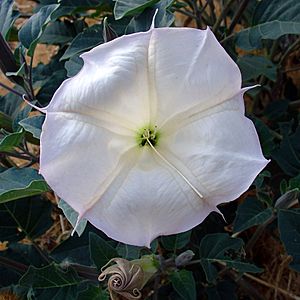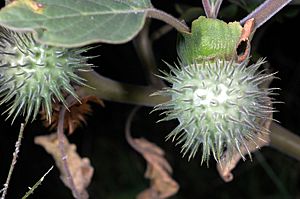Sacred datura facts for kids
Quick facts for kids Sacred datura |
|
|---|---|
 |
|
| Sacred datura in bloom | |
| Scientific classification | |
| Genus: |
Datura
|
| Species: |
wrightii
|
The Datura wrightii, also known as sacred datura, is a beautiful but poisonous plant. It is a perennial plant, meaning it lives for more than two years. This plant is known for its pretty flowers and grows naturally in the Southwestern United States and northwestern Mexico. It belongs to the Solanaceae family, which also includes tomatoes and potatoes!
Contents
What is Sacred Datura?
This plant was first described in 1859 by a German botanist named Eduard August von Regel. He named it after Charles Wright, who collected plant samples in Texas.
People in the United States call it by many names, like "sacred thorn-apple" or "hairy thornapple." Sometimes it's called "western Jimson weed" because it looks similar to another plant. Early settlers in California sometimes called it "Indian whiskey" because some Native American tribes used it in special ceremonies. The name "sacred datura" also comes from this important use.
The Tongva people call this plant manit, and the Chumash call it momoy. In Mexico, similar plants are known as tolguacha or toloache.
Appearance and Features
Sacred datura is a strong plant that can grow from about 30 centimeters (about 1 foot) to 1.5 meters (about 5 feet) tall and wide. Its leaves are wide and rounded at the bottom, then get narrower at the top. They often have wavy edges.
The most amazing part of the plant is its flowers. They are sweet-smelling, white, trumpet-shaped flowers that can be up to 20 centimeters (about 8 inches) long! Sometimes they have a purple tint, especially around the edges. Each flower has five narrow points around its rim. These plants often spread out close to the ground, especially in sunny, open areas like roadsides.
Sacred datura flowers bloom from April all the way through October. On clear days, the flowers open in the morning and evening and close when the sun is hottest. If it's cloudy, they might stay open longer.
After the flowers, the plant grows round, spiny seed pods. These pods are about 3 to 4 centimeters (1.2 to 1.6 inches) across. When the seeds are ready, the capsule opens up.
Where It Grows
You can find Datura wrightii in northern Mexico and the southwestern U. S. states, reaching as far north as southern Utah. It likes open areas, disturbed land, and roadsides with sandy soil that drains well. It's especially common in Southern California.
People also plant sacred datura in gardens as an ornamental plant. It's often used in xeriscapes, which are gardens designed to use very little water.
Is It Invasive?
In some places, like Australia, sacred datura has escaped from gardens and started growing wild. When a plant grows where it's not native and spreads quickly, it can sometimes be called an "invasive species." It has been found growing wild in New South Wales, Victoria, South Australia, and Western Australia.
Safety First: Toxicity
It is very important to know that all parts of Datura plants contain dangerous chemicals. These chemicals are poisonous and can be very harmful if eaten by people, farm animals, or pets. Because of this, you should never touch or eat any part of a datura plant.
How People Use It
Traditional Uses
Native American tribes have used sacred datura for different purposes for a very long time.
Among the Zuni people, the powdered root of the plant was sometimes used to help with pain during surgery. They also made a special paste from the root and flower to put on wounds, which they believed helped them heal.
Cultural Importance
Datura wrightii is considered a sacred plant by some Native American groups, like the Chumash and Tongva people. They have used it in special ceremonies and rites of passage. For example, among the Chumash, it was part of a very serious ceremony for boys when they were around 8 years old. This was meant to be a spiritual challenge to help them grow and become men.
The Zuni people also use the plant in their ceremonial practices, for magical purposes, and for divination (trying to find out about the future or hidden things). For instance, they might chew small pieces of the root to help find out who stole something. Rain priests also used the powdered root in various ways to help bring good rains.
Images for kids
-
Unfolding Sacred Datura buds painted on a Hohokam Sacaton red-on-buff plate, around 950-1150 AD. This was a common design on ancient Native American pottery.




